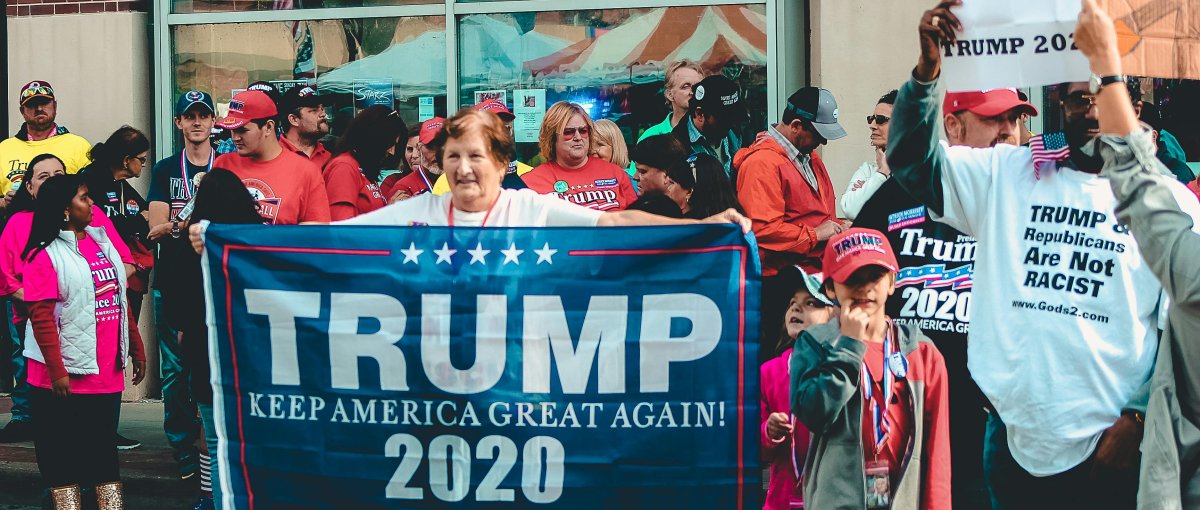Anti-immigration: The rise of Trump and MAGA populism in the USA
With President Trump’s 2024 election, the United States, the leading country of immigration, is witnessing a stunning reversal of its immigration regime including mass deportations and the attempted elimination of birthright citizenship and refugee and asylum seeker protections enshrined in international law.
Anti-immigration: The rise of Trump and MAGA populism in the USA
The United States and European states are experiencing heightened anti-immigrant rhetoric in their right-wing populist movements. US president Donald Trump has called Latinos, Africans, Middle Eastern and Asian immigrants ‘criminals’, ‘monsters’, ‘parasites’, ‘virus’; he has derided Islam and used Hitlerian language to argue that immigrants are ‘poisoning the blood of our country’ (Trip 2023). Trump-like right wing populists, e.g. Wilders (Netherlands), Meloni (Italy), Le Pen (France) and Weidel (Germany) mobilize voters around international migration with the outcome of electoral victory or more restrictive, if not illiberal, immigration policies.
This article argues that Trump’s Make America Great Again (MAGA) movement both dovetails and departs from its contemporary European counterparts.
'Trump and his oligarchical allies actively de/regulate the state for their own gains while compromised state capacity provides diminishing returns for the working poor and middle classes'
On the one hand, MAGA is similar in its voicing of working and middle-class voters’ frustrations over globalization, neoliberal policies, deindustrialization, wage stagnation and unemployment. They mirror each other in the scapegoating of ‘undeserving’ immigrants, refugees and multiculturalism as emblematic of a dysfunctional state run by ‘liberal/leftist elites’ that has overlooked ‘deserving’ ‘common people’. On the other hand, MAGA slightly departs from its European cousins in the blatantly self-interested profit-driven way that Trump and the billionaire oligarchical class, e.g., Musk, Thiel, employ populist rhetoric to mask their pursuits.

Paradoxically, Trump and his oligarchical allies actively de/regulate the state for their own gains while compromised state capacity provides diminishing returns for the working poor and middle classes. All of this is facilitated by the dumbing down of US public education and the celebration of billionaire-owned social media platforms that propagate mis/disinformation about immigration and diversity as the root of ‘common people’s’ misfortune. This article will define populism and the links between contemporary and historical anti-migration rhetoric in US populism, the differences between Trump 1.0 and 2.0 and tease out the ramifications for the robustness of US and liberal democracy worldwide.
Defining populism
Political theorist Müller (2016) defines populism, whether on the left or right, as fundamentally antipluralist and undemocratic. He writes, ‘Populism, I suggest, is a particular moralistic imagination of politics, a way of perceiving the political world that sets a morally pure and fully unified—but, I shall argue, ultimately fictional—people against elites who are deemed corrupt or in some other way morally inferior. While populists may differ on the issues they focus on, they offer a similar message to voters: The ruling elite is corrupt and disdainful of the common citizen.’ (p. 19).
As suggested by Müller, philosopher Habermas regarded the notion of a ‘single, homogenous, authentic people as fantasy’ and argues that the idea of ‘the people’ can only be ‘plural’ (p. 3,4,6). Hence, those deemed ‘elites’ or ‘common citizens’ in populism are both moving targets that change within the matrix of political opportunism and ultimately antidemocratic.
Despite his long history of racism and misogyny, proof of Trump’s appropriation of the ‘common people’ vs. ‘elites’ dichotomy is represented in his 2024 electoral gains across demographics.

Not only did Trump unsurprisingly win the most votes from white voters, middle-aged and rural Americans, election surveys suggest he also won the majority of white women at 53% compared to 60% of white men (Rutgers 2024). Trump performed particularly well among Black men, receiving 24% support versus 9% of the vote from Black women. He also did well among Latino men, with Harris receiving 50% of the vote compared to 47% for Trump, versus 60% to 38% respectively among Latino women. Although 54% of Asian Americans chose Harris, 39% voted for Trump, reflecting a 5 point rightward shift (NBC news). Harris underperformed among 18-29 year old voters, only narrowly beating support for Trump, gaining 52% to his 46% (AP news).zx Trump is the first republican to win both the electoral college and popular vote in 20 years and he and his MAGA republicans control the executive and legislature and have made significant inroads into the judiciary.
Origins of US anti-immigrant populism
The US has a long history of racist and exclusionary immigration policy with preferences for white Western European and Protestant immigrants. Anti-immigrant populism has roots in the beginnings of the US republic and ranges from the Alien and Sedition Acts of 1798, the infamous anti-Irish Catholic and nativist Know Nothing movement of the 1850s and its American Party (where Trump’s ‘America first’ slogan originated), to the Chinese Exclusion Act of 1882, the first federal law targeting a specific ethnic group and effectively restricting immigration. These sentiments continued in the Immigration Act of 1924 with its goal to preserve US ‘homogeneity’. Along with its 1952 iteration, it defined US policy for several decades.
The 1924 Act established the National Origins Quota System of just 2% of each nationality already in the US according to the 1890 US Census and severely restricted immigration from Southern and Eastern Europe (particularly Italians and Jews) and effectively excluded Asians, Africans and other non-white groups. President President Franklin Delano Roosevelt’s 1942 wartime executive order enabled the incarceration of US citizens of Japanese origin without due process. Due to the civil rights movement and pressure from Southern European groups, racial and ethnic preferences in immigration policy changed with the 1965 Immigration and Nationality Act which replaced the discriminatory national origins quota system. The 1965 Act prohibited preferences or discrimination based on race, sex, nationality, place of birth or place of residence. One significant outcome of the 1965 Act was ‘the browning of America’ or the demographic change from nearly exclusively white European immigration to representation from around the world. Trump’s ‘Make America Great Again’ originates in the late President Ronald Reagan’s 1980s campaign slogan Let's Make America Great Again which some view as coded language for a rejection of the diversity and ‘rights revolution’ of the 1960s and 70s that empowered Blacks, Latinos, Asians, Native Americans and women.
Difference between Trump 1.0 and 2.0
The first Trump victory in 2016 was largely unexpected. On winning he rushed and bungled a range of executive orders which allow the US president to issue orders with the force of law without congressional approval. Trump’s included a ‘Muslim’ travel ban, building a wall on the US border with Mexico, ending ‘catch and release’ policies for undocumented immigrants and hiring additional border control agents. Several of these were stopped or limited by the US federal judiciary with civil society input.
'Project 2025 aims to radically deconstruct the federal government in the event of a conservative presidential victory.'
Trump 2.0 is different. He has had years to plan and strategize since his 2020 electoral loss. This has culminated in Project 2025, a 1000-page mandate written by several former Trump administration officials, initially established by the conservative Heritage Foundation and likeminded organizations. Project 2025 aims to radically deconstruct the federal government in the event of a conservative presidential victory. Although Trump feigned ignorance of it, many authors of Project 2025 are in the current Trump administration. Executive orders and measures to limit immigration include allowing federal immigration agents to arrest in schools and churches, closing off the CBP One app that allowed migrants to legally enter to request asylum, the elimination of special humanitarian programmes for migrants, the expansion of expedited removal, deportation of migrants to Guantánamo Bay, Cuba and Panama, and the revocation of all federal funding for municipalities deemed ‘sanctuary’ cities.

Ramifications for democracy
The United States helped to establish the post war liberal democratic order with human rights protections. The Trump model of strong man transactional populist politics by tweet and the blaming of immigrants and diversity for societal woes thinly veils the oligarchical profit-driven state capture that threatens the public good. Mis/disinformation facilitated by billionaire-owned social media, an anti-intellectual ethos and an ill-informed public sows a deep distrust of institutions and jeopardies the US and the entire liberal democratic order.
Democracy requires an educated electorate. Theodor Adorno warned in his 1967 essay ‘Education After Auschwitz’ that democracy requires us to resist the tendency toward social disintegration and the ‘veil of technology’ that fetishizes technology as a proxy for progress. This populist iteration is a litmus test of US and global liberal democratic resilience. People of goodwill must work to replace populism and practice and promote enlightenment values, reading, critical thinking, voting, a credible press and joining organizations that form the foundation of civil society so critical for liberal democracy.
Anti-immigration: The rise of Trump and MAGA populism in the USA

Michael Sharpe is Professor of Political Science and International Migration Studies, City University of New York
Anti-immigration: The rise of Trump and MAGA populism in the USA
Footnotes
Trip, Gabriel. October 5, (2023) Trump Escalates Anti-Immigrant Rhetoric With ‘Poisoning the Blood’ Comment, The New York Times. https://www.nytimes.com/2023/10/05/us/politics/trump-immigration-rhetoric.html
Müller, Jan Werner (2016) What is Populism?. Philadelphia: University of Pennsylvania Press.
Rutgers - Eagleton Institute of Politics (2024) https://cawp.rutgers.edu/blog/gender-differences-2024-presidential-vote
NBC News (2024) https://www.nbcnews.com/news/asian-america/asian-americans-exit-poll-harris-trump-rcna179005
AP (2024) https://apnews.com/projects/election-results-2024/votecast/
